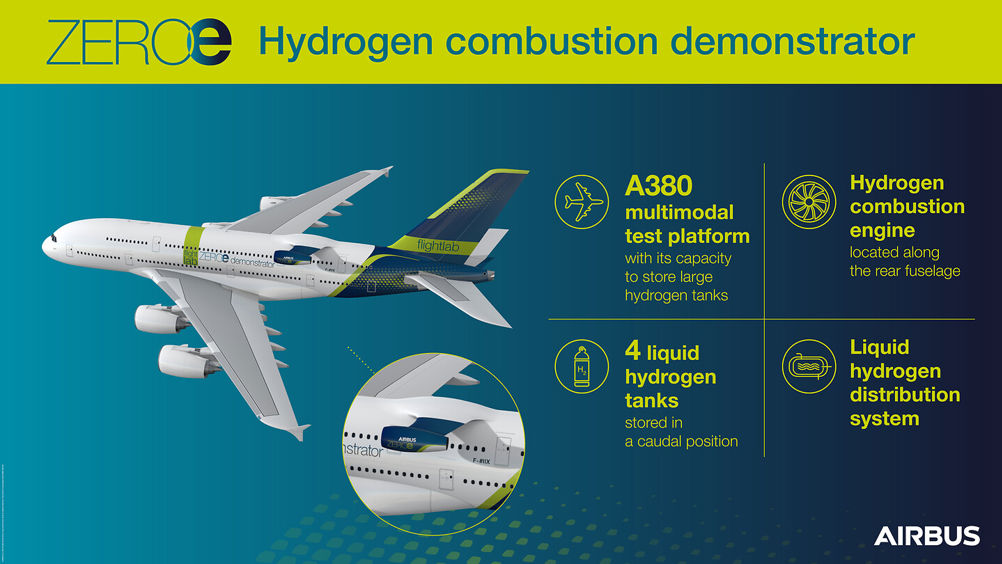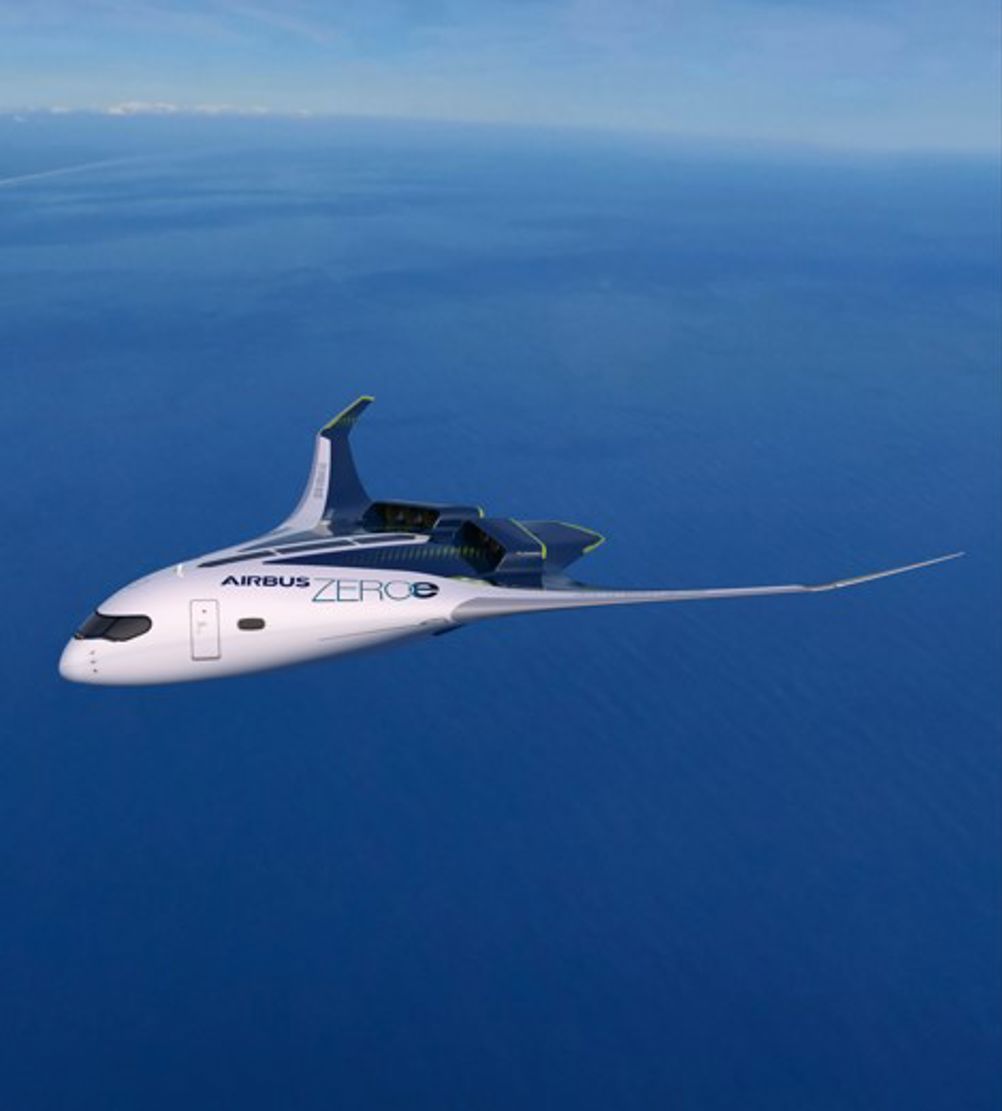Achieving net zero is a global cross-sector effort. But fewer industries face a bigger challenge than civil aviation. IBA, a leading consultancy for the sector, forecasted aviation’s CO2 emissions for 2022 to reach 800 million tonnes — a figure standing at 36 per cent higher than in 2021 — and predicted that in 2023, emissions will match the pre-pandemic peak of 916 million tonnes in 2019.
All of the sector’s major players are aware of the scale of the challenge, and exploring solutions ranging from sustainable aviation fuels (SAF) to the application of hydrogen technologies.
One company feeling optimistic about the task ahead is the world’s largest aircraft manufacturer Airbus, which is confident that by 2035 it will be able to introduce its first ever zero-emission commercial aircraft into service, the hydrogen-powered ‘ZEROe’.
To test the technologies needed to bring it to fruition, the Airbus Zero Emissions Development Centre has launched at its Filton base in Bristol, UK. The Filton ZEDC was established earlier this year with a focus on developing a cost-competitive cryogenic fuel system for the ZEROe.
The work in Filton complements work being done at existing Airbus ZEDCs across Europe. Each ZEDC has a key focus — in France, Germany and Spain, the focus is on the industrialisation side, working on structural technologies for the cryogenic liquid hydrogen tank. In the UK, the ZEDC focuses on the route to certifying the end-to-end fuel system.
“We have a great history here of working on the wings, the fuel systems and the landing gears of Airbus aircraft,” said Sue Partridge, head of the Airbus Filton site and the company’s Wing of Tomorrow programme which explores new approaches to designing and manufacturing aircraft wings.
She added that to have development of the ‘hydrogen systems of the future’ taking place in Filton alongside work being done by the wing team, who’ll need to integrate the new fuel systems into the new air frames, is hugely positive for the company.
“You’ll see lots of facets to decarbonising aviation,” said Claire Smith, VP fuel management domains at Airbus Filton, explaining that SAF will play a large part in the company’s decarbonisation roadmap. “The XLR, the new aircraft that’s in flight test and enters service in 2024, could be flying on 100 per cent sustainable aviation fuel in 20 years.”

But when it comes to hydrogen, an entirely new aircraft design will be required. To begin with, there are some obvious design challenges around storage. Liquid hydrogen has a significantly lower volumetric density compared to kerosene and a boiling point of -252.8C, meaning that specially designed well-insulated cryogenic fuel tanks for liquid hydrogen will be vital for keeping the fuel in liquid state.
Airbus has been exploring several design concepts under the ZEROe umbrella: a turbofan design with a range of 2,000+ nautical miles for 120-200 passengers, a smaller turboprop design for up to 100 passengers suited for shorter-haul journeys, and an innovative blended-wing body (BWB) design for up to 200 passengers.
Hydrogen fuel would be stored in tanks behind the rear pressure bulkhead within the turbofan and turboprop designs, while the BWB concept opens up various storage options thanks to its wide interior.
At the UK ZEDC, Airbus is working with two hydrogen propulsion technologies, a direct-burn option and a fuel cell option. Based on work done over the coming years, a decision is expected to be announced towards the end of the decade on the fuel system that will be chosen.
“Fuel cells’ development and their impact on the range of the aircraft will be part of the criteria, and from a direct burn point of view, the technologies to drive that are in development,” Smith told The Engineer.
She pointed out that at the systems level, many of the challenges are similar around handling cryogenics, developing the necessary refuelling infrastructure and the equipment availability across the supplier landscape for aerospace applications.
“Equipment for a H2 product is all new for aerospace applications. It’s not new and novel for other industries, such as the space industry, but for certifying these types of technology for aerospace applications it is the same challenge for both [fuel systems],” Smith said.
The centre is ‘starting small’ with handling hydrogen, she explained. Then, as understanding of the technologies and development of supply landscape equipment strengthens, Airbus will incrementally test small parts of the system and ultimately the full system before bringing the ZEROe to market.
This will be achieved through the ZEROe flight test demonstrator programme, launched this year with the full flight test expected to take place in the next five years. For this, an Airbus’ A380 MSN1 test aircraft will be modified into a ‘hydrogen propulsion flight laboratory’, enabling valuable knowledge of how the systems will work in real, ground and flight conditions.
As the world’s largest passenger jet, the A380 is well-suited to the challenge of testing hydrogen technologies. Utilising the extra space in the cabin, the test aircraft will carry four liquid hydrogen tanks in a caudal position. A hydrogen combustion engine will be mounted along the rear fuselage. Distribution and conditioning systems will transform the liquid hydrogen to gaseous form and carry it to the gas turbine to be combusted for propulsion.
In addition to ensuring safe handling of hydrogen, safety features will need to be implemented into a hydrogen fuel system to meet the stringent regulations required within the aviation sector, such as sensing technologies for leak detection. Hydrogen has a broad flammability range and can ignite at very low energy levels.
“Airbus puts safety of our products and our people first. It’s the prime concern, we’re already in conversation with the Health and Safety Executive in the UK and in all the other countries that are developing hydrogen systems for Airbus,” said Smith, adding that discussions are also taking place with EASA around the regulations that will need to be in place to certify a hydrogen aircraft.
“We’re taking this exceptionally seriously, we’re doing all of the right things. In terms of the design, the levels of safety factors [within it] are in excess of what we’d normally do,” Smith added.

Aead of the ZEROe flight testing, Airbus is also launching its ‘Blue Condor’ project in the US, in which a modified Arcus-J glider will fly at high altitude powered by a hydrogen propulsion system. With flights set to take place in late 2022, the Blue Condor test campaign will provide crucial knowledge on hydrogen aviation’s non-CO2 emissions, such as NOx, through analysis of contrail properties.
While interest in hydrogen aircraft has skyrocketed in recent years, the concept isn’t new. Back in 1988, the Tupolev-155 made history as the world’s first aircraft to operate on liquid hydrogen, flying around 100 test flights before being put into storage. But despite the history of hydrogen experimentation in aviation, it’s clear that lack of infrastructure and production capacity for green hydrogen have held it back thus far.
“When you’ve got a global aviation sector completely based on kerosene-based fuel, it’s difficult to launch a new innovative hydrogen product,” said Partridge. “It’d be impossible to launch that into the market with all of the infrastructure around it. For me, that’s probably been a barrier to gradual change — it’s going to end up … quite a huge step change at a global level.”
Airbus has formed a consortium - Hydrogen South West - with partners including Bristol Airport, EasyJet, EDF Energy and Bristol Port to address some of these challenges.
“Obviously we don’t produce enough green hydrogen in the UK today so that’s a huge huge hurdle,” said Smith.
“I also sit on the Jet Zero Council Zero Emission Delivery Group, as part of feeding into the UK government to drive that policy, to drive that end-to-end infrastructure.
“Hydrogen is a multi-sector industry, and whether that be houses, vehicles or aircraft, that infrastructure needs to be developed … in a safe, regulated and standardised way. So we’re forming partnerships with organisations that are not necessarily [in] aviation to make sure that happens.”
Despite the challenges Airbus appears to be optimistic about the momentum industry is gaining and its determination to tackle these issues, not just within the UK but across the world.
“The [Net Zero] targets: yes, of course they’re immensely challenging, but they absolutely have to be because we do need an absolute revolution,” Partridge concluded. “In my role I talk to all of the teams around this site, but also we’re both very well connected with all of the Airbus teams around Europe, and I’d say it’s really engaging, it’s really motivating. I don’t think people are finding it an overwhelming challenge, I think they’re seeing it as a really great driver to make a difference.
“Every time we put one of our new aircraft into service today, we do reduce CO2 emissions … Even ramping up our existing production of our very efficient A320neo, for example, makes these contributions. We need to be focusing on those short-term aims as well as the longer-term aims of hydrogen.”





Hard hat mounted air curtain adds layer of protection
Something similar was used by miners decades ago!